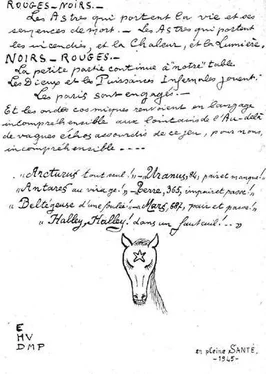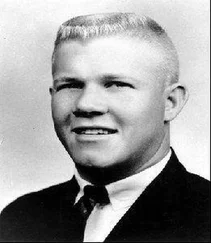Hard at work, Paul sorted through a heap of “thigh bones, craniums, shinbones, ribs, fingers, knee caps, and teeth” at his large marble table. There were two nearly complete skeletons and two half torsos. In most cases, however, they were dealing with bones, such as the ten collarbones, nine sterna, six shoulder blades, and one complete pelvis that had been found, or, more often, fragments too small or deformed to be identified. There were many of those pieces or, as Dr. Paul put it, “three garbage cans full.” There were also several human scalps. The collection of hair alone weighed eleven pounds.
“It’s not an autopsy,” Paul said. “It’s a puzzle.” A puzzle, or rather, as investigators would soon learn, a set of different puzzles with many missing pieces.
6.
THE WOMAN WITH THE YELLOW SUITCASE
I AM A SPECIALIST IN DESTINY AND ITS MYSTERIES, BELIEVE ME. SEIZE YOUR CHANCE. IT’S HERE.
—Jean Cocteau, “Address to Young Writers,”
La Gerbe , December 5, 1940
ASTONE’S throw from Marcel Petiot’s apartment on rue Caumartin, Jean-Paul Sartre was teaching philosophy at the Lycée Condorcet. Outside of class, which was held three and a half days a week during term, Sartre enjoyed spending time in a number of cafés around town. One of his favorites, in the spring of 1944, was Saint-Germain-des-Prés’s then little-known Café de Flore, where he liked to arrive early in the morning and head for his table in the back on the second floor. There, the short, balding, and bespectacled thirty-nine-year-old sat in a red chair, puffing on his pipe and scribbling away with his fountain pen, racing to capture his thoughts in small, tidy letters. Given the wartime shortage of tobacco, Sartre would stop from time to time to retrieve cigarette butts from the floor to stuff into his pipe.
At the other end of the room, at a mahogany marble-topped table, preferably near the stove, sat his friend and lover Simone de Beauvoir. The two deliberately staked out territory at opposite ends of the café to concentrate on their work. About lunchtime, they would break for a meal, most often in Beauvoir’s corner flat on the third floor of the La Louisiane on the rue de Seine. Conversation, no surprise, flowed. “I realized,” Beauvoir once said, “that even though we went on talking till Judgment Day, I would still find the time all too short.”
Sartre was entering into a very productive period that would ultimately send him to the heights of intellectual stardom. In the summer of 1943, he had published his monumental Being and Nothingness , a 722-page philosophical treatise about freedom and responsibility that would become a sensation in the immediate postwar period. At first, however, it was largely ignored. There had only been one review thus far, in René-Marill Albérès’s Etudes et Essais universitaires . Sartre’s friend Jean Paulhan joked that the bulky work would be useful for weighing fruits and vegetables.
That summer, Sartre had also just completed his first major play, The Flies , which was staged at the Sarah Bernhardt Theater, then renamed Theatre de la Cité by the Nazis, to remove the Jewish reference. In this play, which reinterprets the myth of the House of Atreus, young Orestes returns home to Argos amid a plague and the tyrannical rule of Aegisthus, his father’s murderer and now his mother’s lover. Orestes obtains his revenge, murdering the hated usurper and freeing the city from the curse—an appropriate subject for the Occupation that was also subtle enough in its ancient Greek setting to pass the censors.
On the opening night, which, because of electricity cuts, was actually held during the afternoon of June 2, 1943, Sartre was standing in the theater lobby, when a handsome, elegantly dressed young man with gray-green eyes walked up and introduced himself. It was Albert Camus, the twenty-nine-year-old novelist who had the previous year published his first novel, The Stranger . Camus had left his native Algeria in March 1940 to seek a cure for pulmonary tuberculosis at the mountain retreat at Le Panelier near Chambon in Vichy. In November 1942, he had become virtually stranded when the Allies invaded North Africa and the Germans seized the unoccupied zone.
Sartre had reviewed The Stranger in a mostly positive six-thousand-word essay; he was in fact one of the first people to do so, that is, except for the reviews by Camus’s friends or by journals owned by his publisher, Gallimard. The two thinkers, Sartre and Camus, shared many interests, from literature and social justice, to explorations of freedom and absurdity. But the ice really broke, as Simone de Beauvoir put it, when they discussed the theater. Sartre was writing a new play, the future No Exit , and wanted Camus to act in and direct it. Sartre insisted.
As rehearsals began over Christmas 1943, Camus joined Sartre’s circle at Café de Flore, and their friendship grew quickly enough to evoke Beauvoir’s jealousy. Later, she acknowledged that she worried about how Sartre, “the strongest heterosexual I knew,” could fall so completely for the charming stranger. “We were like two dogs circling a bone,” she said of her rival. What Beauvoir did not mention, however, was that she had also been attracted to Camus and once tried to seduce him, only to be rebuffed. “Imagine what she might say on the pillow afterwards,” Camus told his friend and fellow writer Arthur Koestler.
Another place Sartre, Camus, and Beauvoir could be seen that spring was at the restaurant the Catalan, on rue des Grands-Augustins, sometimes seated at the table of their new friend, Pablo Picasso. Despite many invitations to come abroad, the Spanish artist had remained in Paris during the Nazi Occupation, painting in his two-story studio on rue Saint-Augustin, on the Left Bank. The sixty-two-year-old Picasso, with long white hair falling onto his shoulders, was surrounded by his work and his women, including his latest lover, twenty-two-year-old painter Françoise Gilot.
In the eyes of Nazi authorities, Picasso was a highly suspect artist. He had supported Spanish republicans in the Civil War, raised money for their cause, and published caricatures of the military dictator in his Dream and Lie of Franco . He had commemorated the German firebombing raid of the Basque city of Guernica on the afternoon of April 26, 1937, on a three-hundred-square-foot canvas that had dramatically raised awareness of the tragedy. Hitler, of course, had placed the painter on a list of modern degenerates, and the Nazis banned all his exhibits in Paris.
The French police had actually collected a sizable file on the Spanish painter, a dossier that was only discovered in 2003, when 140 cardboard boxes were returned to Paris from Moscow. The Russians had seized the archive in 1945 from the Germans, who in turn had taken it after the Liberation. As historians then learned, Picasso had applied for French citizenship in April 1940, but the state had rejected the application on grounds that he was suspected of being an anarchist or communist, or harboring sympathies leaning in that direction. “He has no right to be naturalized,” an official wrote on the form, and “should even be considered suspect from a national viewpoint.”
Picasso had not told even his closest friends about this request. He had, however, let them know about his fears: namely, that his authorization to remain in the country was about to expire and he had sworn never to return to Spain as long as Franco was in power. Fortunately for Picasso, a sympathetic police official intervened. “Very illegally,” Maurice Toesca wrote in his diary in September 1943, “I have prolonged his stay for three years.”
The Germans who visited Picasso’s studio during the Occupation were not the SS men who were rumored to be slashing his paintings, but instead a number of officials who admired his work. One frequent visitor was Lieutenant Gerhard Heller of the Referat Schriftum (Literature Section) of the Propaganda-Staffel. After his introduction in June 1942, Heller, a censor, would take a break from the stacks of manuscripts overflowing on the shelves, tables, chairs, and floors at his office at 52 Champs-Élysées to climb the spiral staircase, heart beating with excitement at another chance to observe the most infamous example of modern degenerate art at work.
Читать дальше












